Filed under: Best Practices in The Netherlands | Tags: Carbon Disclosure Project, Chemical Sector 2nd generation biofuels, Dow Jones Sustainability Index, DSM, Partnerships, White Biotechnology, World Food Program
DSM is one of the Chemical Sustainability Leaders. Joan Geerts of the Corporate Sustainability Department of DSM presents appealing examples of the development of DSM sustainable products such as carbon neutral polymers and white biotechnology. She also explains how the company is mobilising its employees.
DSM is a multinational Life Sciences and Materials Sciences company, employing worldwide 23,500 employees, generating annual revenues of over 9 billion Euros (1). The company has 5 Business Units: Nutrition (human and animal nutrition & health), Pharma (pharmaceutical products), Performance Materials (resins, engineering plastics), Polymer Intermediates (fibres, textiles and others) and Base Chemicals & Materials (agro, energy, melamine).
DSM products can be found in various business and consumer application areas varying from human food, to pharmaceuticals and fibers :

DSM application areas: Nutrition, Pharma, Performance Materials and Polymers (for fibres)
DSM is internationally known as leader in Sustainable Development : Dutch leader in the Carbon Disclosure Project Index 2009 and Sustainability Chemical Industry Leader in the Dow Jones Sustainability Index. How is Sustainability being managed at DSM?
Safety, health & Environmental issues have historically been well developed. Producer of materials, food and feed additives, antibiotics, etc., DSM has been focusing on managing health and environmental issues. DSM has dedicated departments for Corporate Sustainability and Corporate Operations & Responsible Care. The latter is responsible for all SHE issues (Safety, Health, and Environment) while line management is supported by sustainability and SHE managers at business group level. DSM was first appointed Sustainability Leader in the Dow Jones Sustainability Index in 2004. Fokko Wientjes was appointed as Director of DSM Corporate Sustainable Development in 2006 to streamline the Sustainability Policies and in this role strongly supported by DSM’s Managing Board Deputy Chairman Jan Zuidam. Jan Zuidam chaired the Sustainability Coordination Group, monitoring and aligning all actions and targets with respect to sustainability. In 2009 DSM appointed ‘Sustainability Champions’ in all of the business groups and the DSM Innovation Center. Wientjes and his team is working in close cooperation with these 12 Sustainability Champions to integrate our functional sustainability expertise with a business approach, focusing on business opportunities coming from sustainable development.
Joan Geerts holds an MSC in biopharmaceutical science. Having held different positions within DSM, a.o. in Intellectual Property for over 10 years, she started in the position of Manager Corporate Sustainable Development in 2008. Reporting to Fokko Wientjes, she supports internal and external sustainability activities, such as related to biodiversity, CSR report, engagement of employees and external stakeholder contacts and she is contact person for the Life Science Business Groups.
Joan Geerts, Manager Corporate Sustainable Development at DSM.
1. What are the Sustainability Objectives of DSM ?
Sustainability is an integral part of DSM’s Vision 2010 strategy and objectives. The DSM Vision 2010 strategy, created in 2005, sets out the companies Sustainability Goals:
1. Retain top position in SHE and Sustainability Rankings
2. Maintain global leadership position in ‘White biotechnology’ (*)
3. Continue reducing eco-footprint
4. Developing a more diverse, international workforce
5. Double energy reduction target from 1% to 2% per year.
[ * White Biotechnology is a sustainable development area for DSM. It refers to the biotechnological application of natural micro-organisms (like yeast, which is ‘levure’ in French and ‘gist’ in Dutch) to develop antibiotics and enzymes for, amongst others, food and drinks. In the production of white biotechnology, all materials and dissolving liquids are natural, so the waste products are biodegradable and environmental footprint is limited. DSM has extensive knowledge about this kind of micro-organisms (DSM Gist, until 1998 Gist Brocades Delft and DSM Nutritional Products, until 2001 Roche Fine Chemicals and Vitamins) ]
DSM is currently working on a new strategy and new targets, adds Joan Geerts. This new strategy will take sustainability a step further in the organization and will certainly address further reduction of greenhouse gas emissions, energy and water consumption. DSM also proceeds with calculating eco-footprints of all DSM products.
2. How does CSR contribute to Innovation ?
Sustainability and Corporate Responsibility are drivers for Innovation, confirms Joan Geerts. In fact, Innovation is the life current of DSM. No less than 350 new patents were filed in 2008 of 15,000 patents in total. The Innovations are driven by the companies’ own targets, societal trends and are inspired by and result of cooperation with academic world, industry and NGO partners. The vast majority of newly launched products are ‘ECO+’ with better ecological performance than mainstream competing products.
DSM is reducing its own footprint. Related to 2005, DSM has reduced 3,3 mln tons of CO2 equivalents GHG emissions. The intention is to achieve an additional 25% reduction in the period 2008-2020. The Business Unit DSM Agro achieved to reduce 2 millions tons of CO2 equivalents (N2O emissions) by applying new technology, which goes far beyond legally required emission reduction. DSM Agro obtained the Responsible Care Award 2008 of the Dutch Chemical Industry Association VNCI).
DSM has identified four key societal trends : Climate & Energy, Health & Wellness, Functionality & Performance, Emerging Economies. These trends are with a framework for the key innovation areas of DSM.
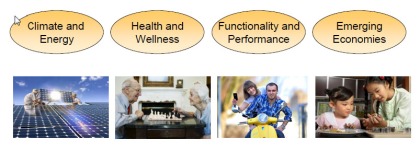
• The trend of ‘Climate and energy’ stimulates DSM developments in renewable sources, like biodegradable plastics, efforts to reduce eco-footprint and green house emissions and development of 2nd generation bio-fuels, generating energy from rest material of natural products, like stems and leaves because we do not want to compete with the food supply chain.

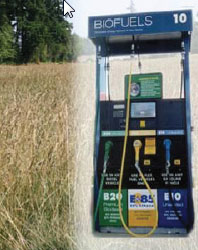
Biodegradable plastics and 2nd generation biofuels are two of the DSM innovation areas related to societal trend ‘Climate and Energy’.
Another example of a DSM innovation fighting climate change is EcoPaXXTM. This polymer is created from the oil generated by so called ‘Castor Beans’. EcoPaXXTM. Is carbon neutral: DSM Engineering has managed to create a product of which 70% is based on the oil of castor beans. This kind of beans is grown on very poor soil. The polymer has excellent mechanical qualities and only melts at 250 degrees Celsius. Castor bean plants absorb CO2 which makes the carbon footprint in the value chain close to, or even below zero.
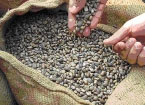
Castor beans, source of new biobased polymer, even appropriate for very infertile soils
It is DSM’s convinction that Governments, NGO’s and Industry should cooperate, e.g. to develop knowledge about carbon footprint reduction or combat global hunger. DSM is actively partnering with NGO’s. As of 2007, DSM is partner of the United Nations World Food Programme (WFP). DSM and WFP have jointly developed the product MixMeTM. The MixMeTM sachets contain food supplements that help provide the necessary and crucial micronutrients for a healthy development of children and for a long-term health of adults. In 2009 DSM reached 700,000 WFP beneficiaries with improved nutrition.
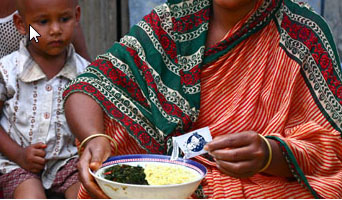
MixMeTM Food supplements developed by DSM and WFP distributed in India
Partnerships with other industry partners. DSM works closely together with many industry partners. An example is the partnership with AkzoNobel, of which we have described Best Practices earlier. Extensive knowledge about resin technology (DSM) and paints (AkzoNobel) are combined to develop new and sustainable painting solutions. AkzoNobel, one of DSM Sustainable Innovation Partners Mobilising employees. Last but not least, DSM is mobilising its own employees in various ways. May 2008, a Sustainability Week was organised in the Delft office to educate DSM employees about sustainability possibilities. The restaurant ran a ‘Food and Sustainability’ program, employee could calculate their own eco-footprint, cradle-to-cradle manufacturing was shown and they learned about the WFP partnership projects. In 2009, a group of young DSM potentials have rolled out a Sustainability Awareness Workshop reaching 1000 DSM employees. Like other companies (Veolia Environnement), Generation Y employees are strong drivers behind Sustainable Change internally.
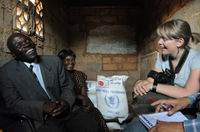
DSM employee-volunteers of the WFP-DSM partnership in action in Zambia
3 Does the economic crisis impact Sustainability Policies at DSM ?
Geerts believes that Ecology and Economy go hand in hand. Many companies have realised that a waste of materials is also waste of costs and valuable resources. The need to manage supply chains, energy/eco efficiency, use-what-you-need and recycle as much as possible is therefore cost effective ánd an environmentally responsible way of working. At DSM the economical crisis has lead to new business challenges as well as cash flow attention. However, the sustainability objectives have not been changed and we will proceed as planned.
4. What are trends and outlooks ?
Sustainability will rise as a Business Priority at DSM and in other companies, expects Joan Geerts. The new Sustainability Targets will take DSM a step further. DSM will continue to strive to a lower carbon footprint and work on sustainable innovations in close cooperation with its partners.
Sources : 1. http://www.dsm.com; 2. ‘DSM is everywhere’, SRI Presentation May 2009; 3. DSM Triple P report 2008. 4. http://www.peopleplanetprofit.be











